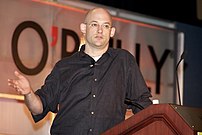Last week, JoAnn Becker and I ran an interactive discussion with the monthly TLA Manager’s breakfast meeting here in Chicago. We had a lively and excellent debate among a group of technology executives, health care executives, and other smart people about the real challenges of successfully deploying information technology to improve productivity and quality in delivering health care in this country.
That, of course, is an immense issue and would could barely scratch the surface in the hour we had. For those who are interested, we’ve uploaded our slides to Slideshare.
We used two recent TV ads from GE and IBM to kick off the discussion. On the surface, each provides a sense for the promise of information technology to make health care more effective:
In the tradition of all good technology vendor advertising, both also completely gloss over the complex organizational adaptation and evolution necessary to bring these hypothetical worlds into being. They also gloss over the existing institutional and industry complexity that needs to be understood and addressed through a combination of design, leadership, and management.
Fred Brooks, professor of computer science at UNC and author of The Mythical Man-Month : Essays on Software Engineering, draws a critical distinction in the final chapter of the book, which is titled "No Silver Bullet," between accidental and essential complexity. His point is that software is so difficult to design and develop because it must successfully model the essential complexity of the domain it addresses. Technology and software efforts can stumble on a variety of barriers and roadblocks, but failing to understand and address essential complexity is the worst.
Health care provides its own mix of accidental and essential complexity. If the decision makers aren’t careful to draw distinctions between accidental and essential, then a great deal of time and effort will be expended without corresponding returns. On the one hand, we may simply succeed in "speeding up the mess" as my friend Benn Konsynski so liked to put it. Or, we may obliterate essential complexities in a quest for uniformity and productivity that is blind to those complexities. Or, finally, we may invest the appropriate level of design time and talent in systems that account for essential complexity and eliminate accidental complexity.
Resources
We drew on a variety of excellent resources in preparing for this talk and wanted to make them more easily available here.
Here are several books that provide useful context and background
- From Novice to Expert: Excellence and Power in Clinical Nursing Practice, Commemorative Edition, Benner, Patricia
- The Innovator’s Prescription: A Disruptive Solution for Health Care, Christensen, Clayton M.
- Better: A Surgeon’s Notes on Performance, Gawande, Atul (my review – Better thinking about performance improvement)
- The Checklist Manifesto: How to Get Things Right, Gawande, Atul (my review – Checklists for more systematic knowledge work)
- The Strategic Application of Information Technology in Health Care Organizations, Glaser, John P.
- Who Killed Health Care?: America’s $2 Trillion Medical Problem – and the Consumer-Driven Cure, Herzlinger, Regina
- The End of Medicine: How Silicon Valley (and Naked Mice) Will Reboot Your Doctor, Kessler, Andy (my review –Business models for health care: Andy Kessler s take on the future of medicine)
- Normal Accidents, Perrow, Charles
Here are pointers to a variety of health care related web resources worth paying attention to:
- HIMSS Health care Information and management systems society
- CHIME College of Healthcare Information Management Executives
- The Advisory Board Company Health Care Performance Management Solutions and Services
- The Health Care Blog
- WSJ Health Blog
- CMS Centers for Medicare and Medicaid Services.
- HL7
- IOM Institute of Medicine. The following two reports are essential reading:
- ICD-10
![Reblog this post [with Zemanta]](http://img.zemanta.com/reblog_e.png?x-id=1e3326d6-3752-4847-9476-4ea309b2a201)

![Reblog this post [with Zemanta]](http://img.zemanta.com/reblog_e.png?x-id=a48bd95e-7bb5-42f6-9558-0608beff7e1e)

![Reblog this post [with Zemanta]](http://img.zemanta.com/reblog_e.png?x-id=ed51c038-c978-4919-a0e4-d384bddcd55c)
![Reblog this post [with Zemanta]](http://img.zemanta.com/reblog_e.png?x-id=ba8a611b-482b-4074-ab1f-e6f994e7a220)

![Reblog this post [with Zemanta]](http://img.zemanta.com/reblog_e.png?x-id=318c90e5-c85c-4abb-9a85-2ed603fa6933)